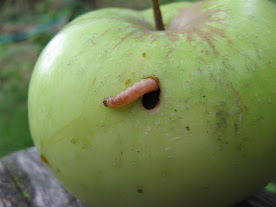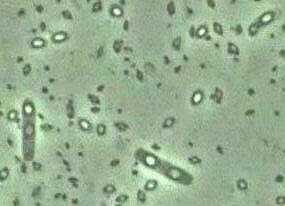I wrote about Codling Moth control back in March, when keeping the moths from mating was the main concern. Now that summer’s here and the fruit is plumping up fast, the worry has shifted to worms (aka larvae). Even the most diligent and pro-active of growers who took every precaution in the spring has reason to fret – Codling Moths are just that hard to get rid of.
Bacillus Thuringiensis v kurstaki (Btk) –
This is another naturally occurring microorganism, but in this case it’s an entomopathogenic fungus and not a bacterium. Spores of this fungus will grow on and spread through plant surfaces and soil. When it encounters a targeted pest,the spores will attach to the pest, enter its body and begin growing inside it. When the pest ultimately dies, the fungus will emerge as part of the decomposition process and continue to release spores and spread infection to the nearest host. In this way, the dead and dying pests continuously propagate the fungus. Like Btk, this biofungicide only works on specific pests and has limited effect on beneficials. We carry PFR-9720% WDG, an OMRI-listed, wettable granular product that can be applied in a variety of ways and combined with most fertilizers, herbicides, pesticides, and beneficial arthropods.
 In many ways, this is the star of these biopesticides. This
baculovirus infects and kills only
the larvae of the codling moth. Sold as an aqueous suspension biological insecticide called CYD-X HP, this product offers extremely
effective targeted biological control. The baculovirus particles in this
product are naturally encapsulated within a protein occlusion body (OB) and, like the spores in PFR-97 20% WDG, they must be ingested to take
effect. Once the OBs are taken in, they will release the virus into the
pest’s body and it’s only a matter of time before death occurs. The virus will
replicate itself inside the body and decomposition will release billions of new
viral OBs into the world. They will then spread by rain, or gravity, or larval movement and infect any larvae they find in an ongoing cycle of infection. CYD-X HP contains 1 trillion OBs and only 1-2 OBs are needed for a lethal infection, so this is some powerful stuff. Numerous scholarly articles and popular websites have touted this as a game-changer for growers since it was first appeared on the scene 15 years ago and after you do a little research I think you’ll see why. This is not a cheap product ($165.99 for 6 oz.), but a little goes a long way (½ - 3 fl. oz. per acre) and it is worth every penny if it gives you piece of mind.
In many ways, this is the star of these biopesticides. This
baculovirus infects and kills only
the larvae of the codling moth. Sold as an aqueous suspension biological insecticide called CYD-X HP, this product offers extremely
effective targeted biological control. The baculovirus particles in this
product are naturally encapsulated within a protein occlusion body (OB) and, like the spores in PFR-97 20% WDG, they must be ingested to take
effect. Once the OBs are taken in, they will release the virus into the
pest’s body and it’s only a matter of time before death occurs. The virus will
replicate itself inside the body and decomposition will release billions of new
viral OBs into the world. They will then spread by rain, or gravity, or larval movement and infect any larvae they find in an ongoing cycle of infection. CYD-X HP contains 1 trillion OBs and only 1-2 OBs are needed for a lethal infection, so this is some powerful stuff. Numerous scholarly articles and popular websites have touted this as a game-changer for growers since it was first appeared on the scene 15 years ago and after you do a little research I think you’ll see why. This is not a cheap product ($165.99 for 6 oz.), but a little goes a long way (½ - 3 fl. oz. per acre) and it is worth every penny if it gives you piece of mind.
Take Care.
Submitted by Pam










It'd be great if there were smaller volume options for purchasing the baculovirus (Cydia pomonella granulovirus) product. Help us backyarders out!
ReplyDelete